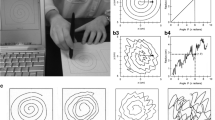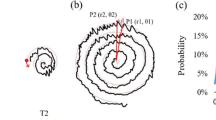Abstract
Essential tremor (ET) is among the most prevalent neurological diseases, yet the location of the primary disease substrate continues to be a matter of debate. The presence of intention tremor and mild gait ataxia suggests an underlying abnormality of the cerebellum and/or cerebellar pathways. Uncovering additional signs of cerebellar dysfunction would further substantiate the proposition that ET is a disease of the cerebellar system. We evaluated 145 ET cases and 34 normal controls clinically and by computerized spiral analysis. Spiral analysis is a program that objectively characterizes kinematic and physiologic features of hand-drawn spirals using specific calculated spiral indices that correlate with spiral shape and motor execution. We used the spiral width variability index (SWVI), a measure of loop-to-loop spiral width variation with the influence of tremor removed, as a metric of drawing ataxia. The SWVI was higher in cases than controls (0.91 ± 1.94, median = 0.46 vs. 0.40 ± 0.29, median = 0.30, p < 0.001). Cases with higher SWVI also had greater intention tremor during the finger–nose–finger maneuver, r = 0.27, p = 0.001), and cases with intention tremor of the head had the highest SWVI (1.57 ± 3.44, median = 0.51, p < 0.001). There was a modest association between SWVI and number of missteps during tandem gait (r = 0.16, p = 0.06). The primary anatomical substrate for ET continues to be a matter of speculation, yet these and other clinical data lend support to the notion that there is an underlying abnormality of the cerebellum and/or its pathways.





Similar content being viewed by others
Explore related subjects
Discover the latest articles and news from researchers in related subjects, suggested using machine learning.References
Louis ED, Ferreira JJ. How common is the most common adult movement disorder? Update on the worldwide prevalence of essential tremor. Mov Disord. 2010;25:534–41.
Benito-Leon J, Bermejo-Pareja F, Morales JM, Vega S, Molina JA. Prevalence of essential tremor in three elderly populations of Central Spain. Mov Disord. 2003;18:389–94.
Louis ED, Frucht SJ, Rios E. Intention tremor in essential tremor: prevalence and association with disease duration. Mov Disord. 2009;24:626–7.
Leegwater-Kim J, Louis ED, Pullman SL, Floyd AG, Borden S, Moskowitz CB, et al. Intention tremor of the head in patients with essential tremor. Mov Disord. 2006;21:2001–5.
Stolze H, Petersen G, Raethjen J, Wenzelburger R, Deuschl G. The gait disorder of advanced essential tremor. Brain. 2001;124:2278–86.
Louis ED, Rios E, Rao AK. Tandem gait performance in essential tremor: clinical correlates and association with midline tremors. Mov Disord. 2010;25:1633–8.
Rao AK, Gillman A, Louis ED. Quantitative gait analysis in essential tremor reveals impairments that are maintained into advanced age. Gait Posture. 2011;34:65–70.
Helmchen C, Hagenow A, Miesner J, Sprenger A, Rambold H, Wenzelburger R, et al. Eye movement abnormalities in essential tremor may indicate cerebellar dysfunction. Brain. 2003;126:1319–32.
Trillenberg P, Fuhrer J, Sprenger A, Hagenow A, Kompf D, Wenzelburger R, et al. Eye–hand coordination in essential tremor. Mov Disord. 2006;21:373–9.
Farkas Z, Szirmai I, Kamondi A. Impaired rhythm generation in essential tremor. Mov Disord. 2006;21:1196–9.
Bares M, Lungu OV, Husarova I, Gescheidt T. Predictive motor timing performance dissociates between early diseases of the cerebellum and Parkinson's disease. Cerebellum. 2010;9:124–35.
Kronenbuerger M, Gerwig M, Brol B, Block F, Timmann D. Eyeblink conditioning is impaired in subjects with essential tremor. Brain. 2007;130:1538–51.
Quattrone A, Cerasa A, Messina D, Nicoletti G, Hagberg GE, Lemieux L, et al. Essential head tremor is associated with cerebellar vermis atrophy: a volumetric and voxel-based morphometry MR imaging study. AJNR Am J Neuroradiol. 2008;29:1692–7.
Nicoletti G, Manners D, Novellino F, Condino F, Malucelli E, Barbiroli B, et al. Diffusion tensor MRI changes in cerebellar structures of patients with familial essential tremor. Neurology. 2010;74:988–94.
Louis ED, Shungu DC, Chan S, Mao X, Jurewicz EC, Watner D. Metabolic abnormality in the cerebellum in patients with essential tremor: a proton magnetic resonance spectroscopic imaging study. Neurosci Lett. 2002;333:17–20.
Benito-Leon J, Alvarez-Linera J, Hernandez-Tamames JA, Alonso-Navarro H, Jimenez-Jimenez FJ, Louis ED. Brain structural changes in essential tremor: voxel-based morphometry at 3-tesla. J Neurol Sci. 2009;287:138–42.
Cerasa A, Messina D, Nicoletti G, Novellino F, Lanza P, Condino F, et al. Cerebellar atrophy in essential tremor using an automated segmentation method. AJNR Am J Neuroradiol. 2009;30:1240–3.
Passamonti L, Novellino F, Cerasa A, Chiriaco C, Rocca F, Matina MS, et al. Altered cortical-cerebellar circuits during verbal working memory in essential tremor. Brain. 2011;134:2274–86.
Kuo SH, Erickson-Davis C, Gillman A, Faust PL, Vonsattel JP, Louis ED. Increased number of heterotopic Purkinje cells in essential tremor. J Neurol Neurosurg Psychiatry. 2011;82:1038–40.
Louis ED. Essential tremor: evolving clinicopathological concepts in an era of intensive post-mortem enquiry. Lancet Neurol. 2010;9:613–22.
Kuo SH, Faust PL, Vonsattel JP, Ma K, Louis ED. Parallel fiber counts and parallel fiber integrated density are similar in essential tremor cases and controls. Acta Neuropathol. 2011;121:287–9.
Erickson-Davis CR, Faust PL, Vonsattel JP, Gupta S, Honig LS, Louis ED. "Hairy baskets" associated with degenerative Purkinje cell changes in essential tremor. J Neuropathol Exp Neurol. 2010;69:262–71.
Louis ED, Faust PL, Ma KJ, Yu M, Cortes E, Vonsattel JP. Torpedoes in the cerebellar vermis in essential tremor cases vs controls. Cerebellum. 2011;4:812–9.
Pullman SL. Spiral analysis: a new technique for measuring tremor with a digitizing tablet. Mov Disord. 1998;13 Suppl 3:8589.
Louis ED, Yu Q, Floyd AG, Moskowitz C, Pullman SL. Axis is a feature of handwritten spirals in essential tremor. Mov Disord. 2006;21:1294–5.
Hsu AW, Piboolnurak PA, Floyd AG, Yu QP, Wraith JE, Patterson MC, et al. Spiral analysis in Niemann–Pick disease type C. Mov Disord. 2009;24:1984–90.
Louis ED, Faust PL, Vonsattel JP, Honig LS, Rajput A, Robinson CA, et al. Neuropathological changes in essential tremor: 33 cases compared with 21 controls. Brain. 2007;130:3297–307.
Louis ED, Borden S, Moskowitz CB. Essential tremor centralized brain repository: diagnostic validity and clinical characteristics of a highly selected group of essential tremor cases. Mov Disord. 2005;20:1361–5.
Louis ED, Rios E, Henchcliffe C. Mirror movements in patients with essential tremor. Mov Disord. 2009;24:2211–7.
Fahn S, Elton R, Members of the UPDRS Development Committee in Fahn S, Marsden C, Goldtein M, Calne DB (ed) (1987) Recent developments in Parkinson's disease. Florham Park, NJ, Macmillan Health Care Information. pp 153–63.
Longstaff MG, Heath RA. Spiral drawing performance as an indicator of fine motor function in people with multiple sclerosis. Hum Mov Sci. 2006;25:474–91.
Louis ED, Ottman R, Ford B, Pullman S, Martinez M, Fahn S, et al. The Washington Heights-Inwood Genetic Study of essential tremor: methodologic issues in essential tremor research. Neuroepidemiology. 1997;16:124–33.
Acknowledgments
R01 NS042859 from the National Institutes of Health (Bethesda, MD, USA; EDL) and support from the Parkinson Disease Foundation (New York, NY, USA; CWH, SLP).
Author information
Authors and Affiliations
Corresponding author
Rights and permissions
About this article
Cite this article
Louis, E.D., Gillman, A., Boschung, S. et al. High Width Variability during Spiral Drawing: Further Evidence of Cerebellar Dysfunction in Essential Tremor. Cerebellum 11, 872–879 (2012). https://doi.org/10.1007/s12311-011-0352-4
Published:
Issue Date:
DOI: https://doi.org/10.1007/s12311-011-0352-4




